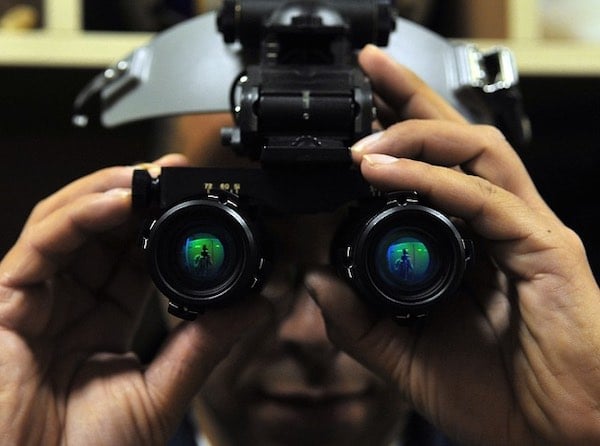Wearable Electronics in the Military: Why and How?
According to a U.S. Department of Defense report, no less than 7,000 U.S. servicemen have been killed in various locations across the globe, particularly the Middle East. In addition to extensive training and weaponisation, militaries are increasingly utilising intelligent technologies to enhance the survivability of soldiers at the battlefront.
Military wearables are portable, lightweight, and/or miniaturised devices that are located on, near, or in the body, and they provide a host of intelligent functions to soldiers, including situational awareness, health and safety monitoring, communications, power, and interconnectivity.
Situational Awareness
By measuring thermal radiation, headset-based IR sensors and night vision goggles allow soldiers to detect enemy presence in areas with limited lighting. Infrared sensors consist of an infrared light-emitting diode (or IRLED) that serves as the transmitter, and an IR photodiode as the detector capable of measuring IR light of the same wavelength.
Similarly, inertial sensors embedded into soldiers’ clothing or portable equipment can detect motion and body orientation. Inertial sensors consist of microelectromechanical systems, namely sensors that contain capacitive elements and mechanical structures on the same semiconductor substrate.
Health and Safety Monitoring
Monitoring the vital signs of soldiers in the field is another profound application of wearable electronics. For example, Bodytrak, a biometric sensor manufacturer, has designed a physiological monitoring device that soldiers can wear in the ear. Similarly, DARPA is funding research into an implantable biosensor that can measure body glucose, oxygen, and lactate, to reveal when a soldier is starting to fall ill before they’ve even shown symptoms.
Electronic sensors are integral components of health and safety monitoring wearables. For example, toxic gas sensors and combustible gas detectors detect the presence of noxious or flammable gases in a soldier’s immediate environment. Toxic gas sensors utilise metal-oxide semiconductors whose electric conductivities vary depending on the levels of toxic gases present in the atmosphere. Combustible gas detectors detect the lower explosive limit (or LEL) of combustible gases via a Wheatstone bridge and a heated platinum filament. When a toxic gas comes in contact with the filament, it varies the resistance of the bridge, which corresponds to toxic gas concentration on the LEL display.

Situational awareness is a critical focus for the military wearables industry. Pictured: a face-on view of a soldier looking through night vision goggles. Image Credit: Pixabay.
Communications
Audio, video, and data communication is a critical focus in the military wearables industry. Smart wearables devices, such as body cameras, microphones, and radios can fit into standard military fatigues. Moreover, military communications require secure protocols to prevent signals from being intercepted during transmission. For example, navigation and location mapping wearables utilise GPS and Precise Positioning Service (an encrypted GPS type utilised in military service broadcasting) provide positional, velocity, and timing information to soldiers in real time.
According to Military Simulation and Training Magazine, the typical warfighter gear weighs at least 60 pounds, therefore lightweight, size, and ease of integrating portable communications devices into military clothing is an essential focus for manufacturers. Rapid miniaturisation of portable telephony and computers (due to rapid advances in chip design) is boosting the growth of military wearables. Today’s soldiers communicate using a wide range of body-worn devices, such as smartwatches, modified headsets, and ear implants.
Power
Providing smart, reliable power is one of the most challenging aspects when it comes to designing wearable devices for the military. The reason for this is the limited energy densities of conventional lithium battery technology. Engineers are solving this challenge by designing wearables that produce power on the go. For example, SolePower, a smart boots manufacturer, designs military boots that generate power as they strike the ground. These intelligent boots contain a patented kinetic energy harvesting device in the heel that generates electric charges (up to 100mW) as the wearer marches or runs.

A soldier takes aim while crouching at a desert outpost. Image Credit: Pixabay.
Interconnectivity
High-integrity electrical connections ensure reliable power transmission in wearables. Connector cables provide electrical connectivity between portable energy storage and body-worn devices. A good example is ITT Cannon’s ruggedised connectors for soldier-worn devices, such as the MKJ Nett Warrior connectors that are utilised in handheld radios, portable computers, and tablets.
A Sustainable Trend for the Future Soldier
Given their provision of reliable communications, situational awareness, performance, safety, and other benefits to military personnel both on and off the battlefield, wearable electronics will continue to be a staple part of the military for the foreseeable future.
Expectedly, the market for military wearables is expanding: leading market research predicts that it will grow no less than 7.2% between 2019 and 2025. Wearables have proven to provide cost savings, safety, and reliable sensing capabilities in even the most extreme operating conditions and environments.





